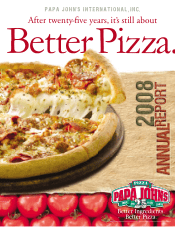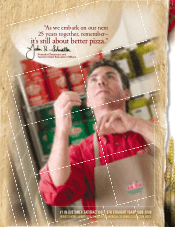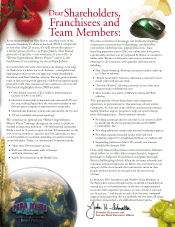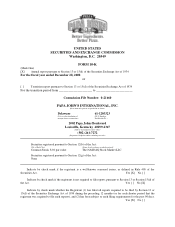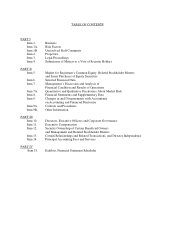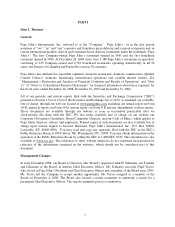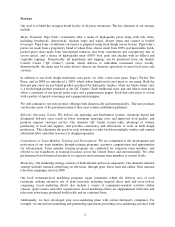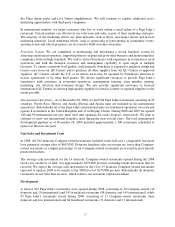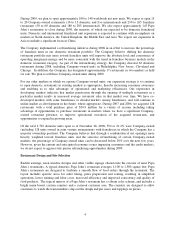Papa Johns 2008 Annual Report Download - page 9
Download and view the complete annual report
Please find page 9 of the 2008 Papa Johns annual report below. You can navigate through the pages in the report by either clicking on the pages listed below, or by using the keyword search tool below to find specific information within the annual report.2
Strategy
Our goal is to build the strongest brand loyalty of all pizza restaurants. The key elements of our strategy
include:
Menu. Domestic Papa John’s restaurants offer a menu of high-quality pizza along with side items,
including breadsticks, cheesesticks, chicken strips and wings, dessert items and canned or bottled
beverages. Papa John’s traditional crust pizza is prepared using fresh dough (never frozen). Papa John’s
pizzas are made from a proprietary blend of wheat flour, cheese made from 100% real mozzarella, fresh-
packed pizza sauce made from vine-ripened tomatoes (not from concentrate) and a proprietary mix of
savory spices, and a choice of high-quality meat (100% beef, pork and chicken with no fillers) and
vegetable toppings. Domestically, all ingredients and toppings can be purchased from our Quality
Control Center (“QC Center”) system, which delivers to individual restaurants twice weekly.
Internationally, the menu may be more diverse than in our domestic operations to meet local tastes and
customs.
In addition to our fresh dough traditional crust pizza, we offer a thin crust pizza, Papa’s Perfect Pan
Pizza, and in 2008 we introduced a 100% whole-wheat hand-tossed crust pizza to our menu. Both the
thin and pan crusts are par-baked products produced by third-party vendors, while our whole-wheat crust
is a fresh-dough product produced at our QC Centers. Each traditional crust, pan and wheat crust pizza
offers a container of our special garlic sauce and a pepperoncini pepper. Each thin crust pizza is served
with a packet of special seasonings and a pepperoncini pepper.
We will continue to test new product offerings both domestically and internationally. The new products
can become a part of the permanent menu if they meet certain established guidelines.
Efficient Operating System. We believe our operating and distribution systems, restaurant layout and
designated delivery areas result in lower restaurant operating costs and improved food quality, and
promote superior customer service. Our domestic QC Center system takes advantage of volume
purchasing of food and supplies, and provides consistency and efficiencies of scale in fresh dough
production. This eliminates the need for each restaurant to order food from multiple vendors and commit
substantial labor and other resources to dough preparation.
Commitment to Team Member Training and Development. We are committed to the development and
motivation of our team members through training programs, incentive compensation and opportunities
for advancement. Team member training programs are conducted for corporate team members, and
offered to our franchisees at training locations across the United States and internationally. We offer
performance-based financial incentives to corporate and restaurant team members at various levels.
Marketing. Our marketing strategy consists of both national and local components. Our domestic national
strategy includes national advertising on television, through print, direct mail and online. Nine national
television campaigns aired in 2008.
Our local restaurant-level marketing programs target consumers within the delivery area of each
restaurant, making extensive use of print materials including targeted direct mail and store-to-door
couponing. Local marketing efforts also include a variety of community-oriented activities within
schools, sports venues and other organizations. Local marketing efforts are supplemented with radio and
television advertising, produced both locally and on a national basis.
Additionally, we have developed joint cross-marketing plans with certain third-party companies. For
example, we entered into marketing and partnership agreements providing cross-marketing activities with

